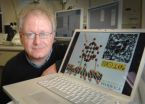(Press-News.org) The single layer material Graphene was the subject of a Nobel prize this year but research led by a team of researchers at the University of Warwick has found molecular hooks on the surface of its close chemical cousin, Graphene Oxide, that will potentially provide massive benefits to researchers using transmission electron microscopes. They could even be used in building molecular scale mechanisms.
The research team, which includes Drs. Jeremy Sloan, Neil Wilson and PhD student Priyanka Pandey from the Department of Physics and Dr. Jon Rourke from the Department of Chemistry together with the groups of Drs. Kazu Suenaga and Zheng Liu from AIST in Japan and Drs. Ian Shannon and Laura Perkins in Birmingham were looking at the possibility of using Graphene as a base to mount single molecules for imaging by transmission electron microscopy. As Graphene forms an electron transparent sheet just one atom thick it would enable high precision, high contrast imaging of the molecules being studied as well as the study of any interactions they have with the supporting graphene.
While this idea is great in theory, Graphene is actually very difficult to create and manipulate in practice. The researchers therefore turned to Graphene's easier to handle cousin, Graphene Oxide. This choice turned out to be a spectacularly better material as they found extremely useful properties, in the form of ready-made molecular hooks that could make Graphene Oxide the support material of choice for future transmission electron microscopy of any molecule with oxygen on its surface.
Graphene Oxide's name obscures the fact that it is actually a combination of carbon, oxygen and hydrogen. For the most part it still resembles the one atom thin sheet of pure Graphene, but it also has "functional groups" consisting of hydrogen paired with oxygen. These functional groups can bind strongly to molecules with external oxygens making them ideal tethers for researchers wishing to study them by transmission electron microscoscopy.
This feature alone will probably be enough to persuade many researchers to turn to Graphene Oxide as a support for the analysis of a range of molecules by transmission electron microscopy, but the researchers found yet another intriguing property of these handy hooks – the molecules attached to them move and pivot around them.
Dr Jeremy Sloan said:
"Under the right conditions the functional groups not only provide molecular tethers that hold molecules in an exact spot they also allow the molecule to be spun in that position. This opens up a range of new opportunities for the analysis of such molecules but could also be a useful mechanism for anyone seeking to create molecular sized "machinery"."
INFORMATION:
Notes for editors:
The research paper is entitled "Imaging the Structure, Symmetry, and Surface-Inhibited Rotation of Polyoxometalate Ions on Graphene Oxide" is published in Nano Letters and is by Dr Jeremy Sloan, Jonathan P. Rourke, Neil R. Wilson and Priyanka A. Pandey from the University of Warwick; Zheng Liu and Kazu Suenaga from National Institute for Advanced Industrial Science and Technology (AIST), Research Centre for Advanced Carbon Materials, Tsukuba, Ibaraki Japan; and Laura M. Perkins and Ian J. Shannon from the University of Birmingham.
The research was funded or supported by the University of Warwick's Warwick Centre for Analytical Science funded by the EPSRC, the Royal Society, the Science City initiative funded by Advantage West Midlands , AIST and had access to equipment from the Department of Materials at the University of Oxford.
For further information please contact:
Dr Jeremy Sloan
Department of Physics
University of Warwick
Tel: 02476 5 23392
email: j.sloan@warwick.ac.uk
Peter Dunn, email: p.j.dunn@warwick.ac.uk
Head of Communications, Communications Office, University House,
University of Warwick, Coventry, CV4 8UW, United Kingdom
Tel: +44 (0)24 7652 3708
Mobile: +44 (0)77 6765 5860
Pivoting hooks of graphene's chemical cousin could revolutionize work of electron microscopes
2010-11-02
ELSE PRESS RELEASES FROM THIS DATE:
New strain of 'high-runner' rats uniquely resistant to disease -- all disease!
2010-11-02
Everybody knows that if you're physically fit, you're less likely to get a wide range of diseases. What most people don't know is that some people are "naturally" in better shape than others, and this variation in conditioning makes it difficult to test for disease risk and drug effectiveness in animal models. A new research paper published in the November 2010 print issue of The FASEB Journal (http://www.faseb.org) started out as a study to explain the strong statistical link between low aerobic exercise capacity and common diseases, but ultimately led to an animal model ...
Scientists turn a new leaf to discover a compound in daffodils that targets brain cancer
2010-11-02
When looking for new ways to treat aggressive brain cancers, an international team of scientists turned a new leaf and "discovered" the lowly daffodil. A new research study published in the November 2010 print issue of The FASEB Journal (http://www.fasebj.org) offers hope that a natural compound found in daffodil bulbs, called narciclasine, may be a powerful therapeutic against biologically aggressive forms of human brain cancers.
"We are planning to move a narciclasine derivative toward clinical trials in oncology within a three to four year period in order to help patients ...
Scientists uncover a genetic switch that turns immune responses on and off
2010-11-02
Scientists are keeping their eye on a new discovery published in the November 2011 print issue of the FASEB Journal (http://www.fasebj.org) that explains what causes some genes to go out of control. Scientists have identified a "cellular switch," called eye transformer, that controls the flow of information from chemical signals outside of the cell to genes in the cell nucleus. This study demonstrates that when eye transformer is turned off, the information pathway it controls (the "JAK/STAT pathway") hyper-activates. Because this pathway exists in humans and is involved ...
Mayo researchers find mortality rates from liver diseases underestimated
2010-11-02
ROCHESTER, Minn. -- Statistics from the Centers for Disease Control and Prevention (CDC) (http://www.cdc.gov/) rank mortality related to chronic liver disease and cirrhosis as the 12th most common cause of death in adults in the U.S. Using a modified definition that includes diseases such as viral hepatitis, liver cancer (http://www.mayoclinic.org/liver-cancer/) and obesity-related fatty liver disease (liver diseases)(http://www.mayoclinic.org/liver-disease/), Mayo Clinic-led researchers have found that liver-related mortality is as high as fourth for some age groups, and ...
MRI contrast agents change stem cell proliferation
2010-11-02
Tampa, Fla. (Nov. 01, 2010) – When researchers tested three different labeling agents on three different stem cell populations to determine what effect the labeling agents had on stem cell phenotype, biological behavior and migration abilities, they found changes in stem cell proliferation depending on the type of contrast agent used.
The team of researchers from Belgium and Spain tested USPIO (ultra small superparamagnetic iron oxide) contrast agents Resovist ®, Endorem ® and Sinerem ® on mouse embryonic stem cells (mESC), rat multipotent adult progenitor cells (rMAPC) ...
Slight change in wind turbine speed significantly reduces bat mortality
2010-11-02
While wind energy has shown strong potential as a large-scale, emission-free energy source, bat and bird collisions at wind turbines result in thousands of fatalities annually. Migratory bats, such as the hoary bat, are especially at risk for collision with wind turbines as they fly their routes in the forested ridges of the eastern U.S. This loss not only impacts the immediate area, but is also detrimental to ecosystem health nationwide—that is, bats help with pest management, pollination and the dispersal of numerous plant seeds.
Since turbine towers and non-spinning ...
Voting-machine-allocation method could reduce voters' wait time by 36 percent
2010-11-02
With a lifelong interest in politics, University of Cincinnati researcher Muer Yang spent the last two years developing a quantitative method for allocating voting machines that could significantly reduce the average wait time of voters.
During the 2004 U.S. presidential elections, some voters waited in lines for more than 10 hours to cast their ballots, and in Ohio, the last vote was cast at 4 a.m., noted Ohio Secretary of State Jennifer Brunner in a public report. Ohio lines in the '06 and '08 elections were still so lengthy that they essentially "disenfranchised" voters ...
Study: Race plays a minor role in forging Facebook friendships
2010-11-02
CAMBRIDGE, Mass., Nov. 1, 2010 -- Race may not be as important as previously thought in determining who befriends whom, suggests a new study of American college students' habits on Facebook. The findings, by a pair of sociologists from Harvard University and UCLA, appear in the current issue of the American Journal of Sociology.
The strongest attraction, the researchers found, turned out to be old-fashioned social pressure. For the average student, the tendency to reciprocate a friendly overture is seven times stronger than the attraction of a shared racial background.
"We ...
King crab distributions limited by temperature in the Southern Ocean
2010-11-02
Invasions of voracious predatory crabs due to global warming could threaten the unique continental-shelf ecosystems of Antarctica, according to newly published findings.
"King crabs are ecologically important predators and form the basis of economically significant commercial fisheries," said Dr Sven Thatje, an evolutionary ecologist at the University of Southampton's School of Ocean and Earth Science (SOES), which is based at the National Oceanography Centre in Southampton.
Thatje and graduate student Sally Hall studied how water temperature influences the distributions ...
Scientists find that evergreen agriculture boosts crop yields
2010-11-02
THE HAGUE (2 November 2010)—A unique acacia known as a "fertilizer tree" has typically led to a doubling or tripling of maize yields in smallholder agriculture in Zambia and Malawi, according to evidence presented at a conference in the Hague today. The findings were central to the arguments of agroforestry experts at the conference, who urged decision makers to spread this technology more widely throughout the African nations most vulnerable to climate change and food shortages, and to think differently about more practical ways to solve the problems that are most pressing ...


